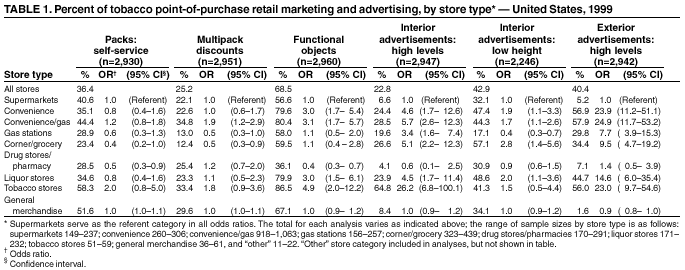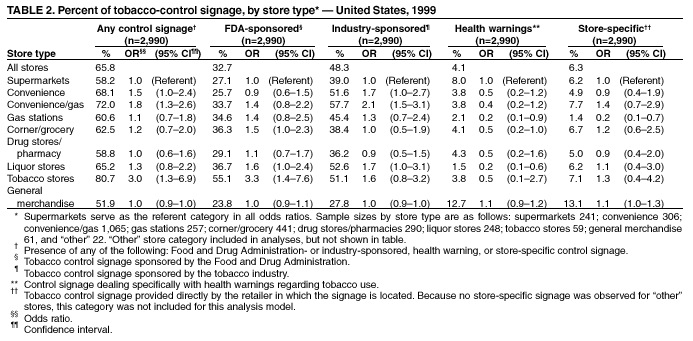 |
|
|
|
|
|
|
| ||||||||||
|
|
|
|
|
|
|
||||
| ||||||||||
|
|
|
|
|
Persons using assistive technology might not be able to fully access information in this file. For assistance, please send e-mail to: mmwrq@cdc.gov. Type 508 Accommodation and the title of the report in the subject line of e-mail. Point-of-Purchase Tobacco Environments and Variation by Store Type --- United States, 1999To promote its products, the tobacco industry spent $8.2 billion on marketing in 1999, an increase of $1.5 billion over the previous year (1). Tobacco advertising in various media increases tobacco consumption (2) and adolescents are more susceptible than adults to being influenced by some forms of tobacco advertising (3). To describe the retail tobacco advertising and marketing environment, researchers from the Robert Wood Johnson Foundation-sponsored ImpacTeen Project* collected and analyzed store observation data in 163 communities throughout the United States. This report summarizes the extent of point-of-purchase (POP) tobacco advertising and marketing found in various types of stores. The findings in this report indicate that certain retail environments frequented by teenagers heavily promote tobacco use. To reduce demand for tobacco products among adolescents, public health efforts should address POP environment exposure to tobacco advertising and marketing. During a 4-month period in 1999, ImpacTeen researchers observed POP environments in 3,031 retail outlets in 163 communities with public schools participating in the nationally representative Monitoring the Future (MTF) study of eighth-, 10th-, and 12th-grade students (4). Private and magnet schools (comprising approximately 20% of the original sample) were not included in this study. Community boundaries were defined by the area from which each school drew at least 80% of its student population. Random samples of up to 30 retailers per community were drawn from lists of stores selling tobacco and/or liquor products as identified by their Standard Industrial Classifications (SIC) Index codes†. Two additional samples of 10 stores each were drawn as replacements for any stores on the original list that did not meet study criteria (i.e., those that had ceased business, had relocated, were not open during the days observers were on site, or did not sell tobacco products). If field observers could not reach the desired sample size of 30 using the original and replacement lists of retailers, they added tobacco retailers identified on site. Of the 3,031 observed stores, 2,309 (76.2%) were from the original sample, 355 (11.7%) were from randomly generated replacement lists, and 367 (12.1%) were added in the field based on study protocol. Overall, 2,999 (98.9%) of all observed stores were tobacco retailers and were eligible for inclusion in the study. Field observers collected information on the presence of various POP tobacco environment features including 1) tobacco product placement (self-service versus clerk-assisted); 2) promotions (multipack/cents-off discounts and gift-with-purchase offers); 3) tobacco-branded functional objects (free items provided by the industry such as counter change mats or shopping baskets displaying the sponsoring company's logo); 4) presence and extent of exterior and interior advertisements (such as those indicating special prices); 5) presence of low-height interior advertising or advertisements directly in the line of sight of very young children (at a height of <3½ feet above the floor); and 6) tobacco-control signage (including Food and Drug Administration [FDA]§- or industry-sponsored signage, health warnings, or messages indicating that identification is required to purchase tobacco products). Data were weighted to account for both the community-level multistage sampling procedures and the store selection probabilities. The GENMOD procedure in SAS v.8 was used to run generalized estimating equations that accounted for community clustering while specifying a binomial distribution and a logit link function. Results were expressed as unadjusted odds ratios and 95% Wald confidence intervals. For all analyses, supermarkets were used as the referent category. Some form of tobacco POP presence (i.e., interior or exterior advertising, self-service pack placement, multipack discounts, tobacco-branded functional objects, or vending machines) was observed in 92.1% of the stores: self-service cigarette pack placement in 36.4%, multipack discounts in 25.2%, and at least one tobacco-branded functional object in 68.5%. Most (80%) retailers displayed interior tobacco advertising; 22.8% had high levels of interior advertising (i.e., advertisements outside areas where tobacco products were sold or displayed), and 42.9% had low-height advertisements. Exterior tobacco advertisements were observed in 58.9% of the stores, with 40.4% having high levels of exterior advertising (i.e., five or more advertisements or at least one advertisement >1 foot in any dimension). Some form of tobacco advertising (interior or exterior) was present in 84.1% of the stores. Convenience/gas retailers were significantly more likely to have five of the six POP measures, convenience and liquor stores were significantly more likely to have four of the measures, and drug stores were significantly less likely to have two of the measures (Table 1). Tobacco-control signage was observed in 65.8% of the stores (Table 2). Forty-eight percent of stores had industry-sponsored signage warning minors that proof of age is required to purchase tobacco products (e.g., "We Card" signs), 32.7% had FDA-sponsored signage, 4.1% had health warning signs, and 6.3% had other minors' access signs. Convenience stores and convenience/gas stores were significantly more likely to have industry-sponsored signs. Both gas stations and liquor stores were significantly less likely to have health warning signage. Reported by: Y Terry-McElrath, MSA, Univ of Michigan, Ann Arbor. M Wakefield, PhD, Anti-Cancer Council of Victoria, Australia. G Giovino, PhD, A Hyland, PhD, Roswell Park Cancer Institute, New York, New York. D Barker, MHS, Barker Bi-Coastal Health Consultants, Calabasas, California. F Chaloupka, PhD, S Slater, MS, Univ of Illinois at Chicago. P Clark, PhD, Battelle Memorial Institute, Baltimore, Maryland. M Schooley, MPH, L Pederson, PhD, T Pechacek, PhD, Office on Smoking and Health, National Center for Chronic Disease Prevention and Health Promotion, CDC. Editorial Note:The findings in this report indicate that convenience, convenience/gas, and liquor stores were most likely to have pro-tobacco environments (i.e., environments in which patrons are exposed to high levels of tobacco-related advertisements, promotions, and functional objects). Convenience and convenience/gas stores account for the largest share of retail tobacco sales (5). Because 75% of teenagers shop at convenience or convenience/gas stores at least once a week (6), adolescents will continue to be exposed to high levels of tobacco POP influence unless pro-tobacco marketing in these retail environments is restricted. Although virtually all tobacco retailers in this study had some form of tobacco POP presence, fewer of these stores had a visible tobacco-control environment, and even fewer displayed health warnings. Although this study did not measure the extent of tobacco-specific control signage, observers generally reported that pro-tobacco signage predominated. The findings in this report are subject to at least three limitations. First, only retailers in communities with public schools participating in the MTF study were included in this report and might not be representative of all stores in the United States. Second, although original and replacement retailer selection was random, no effort was made to ensure that the various store types were represented proportionally. Third, some minor differences were observed between both replacement stores and stores added in the field when compared with other stores. Replacement stores were less likely to have multipack promotions, counter signage, and FDA-sponsored signage. Added stores were less likely to have functional objects or FDA-sponsored signage, were more likely to have packs available via self-service, and showed some differences in store type (fewer other and corner/grocery stores, and more liquor stores). No significant differences were observed for either replacement or added stores with regard to either presence or extent of exterior or interior tobacco advertising. Exposure to POP advertising and marketing influences youth access to, experimentation with, and purchase of cigarettes (7--9). Public health efforts should include strategies to decrease pro-tobacco POP environment exposure and reduce demand for tobacco products among adolescents. Recommendations include eliminating or severely restricting self-service product displays, free samples, functional objects, and advertisements (10). Public practitioners or policy makers may facilitate the implementation of these recommendations by working with retailer associations and within communities to decrease overall POP tobacco-promotion activities. Initial efforts should target those store types most frequented by adolescents in which a pro-tobacco environment predominates. References
* A policy research partnership for reducing youth substance use. Member institutions include the University of Illinois at Chicago, the University of Michigan, Andrews University, Roswell Park Cancer Institute, and the University of Minnesota. † A numeric system used to classify U.S. industries and businesses for the collection, analysis, and dissemination of industry statistics developed by the Office of Management and Budget. § FDA-sponsored signage was created prior to March 2000. As a result of a ruling in 2000 by the U.S. Supreme Court (FDA v. Brown & Williamson Tobacco Corp., 120 S. Ct. 1291), the FDA has withdrawn programs regulating conventionally marketed tobacco products. Table 1  Return to top. Table 2  Return to top.
Disclaimer All MMWR HTML versions of articles are electronic conversions from ASCII text into HTML. This conversion may have resulted in character translation or format errors in the HTML version. Users should not rely on this HTML document, but are referred to the electronic PDF version and/or the original MMWR paper copy for the official text, figures, and tables. An original paper copy of this issue can be obtained from the Superintendent of Documents, U.S. Government Printing Office (GPO), Washington, DC 20402-9371; telephone: (202) 512-1800. Contact GPO for current prices. **Questions or messages regarding errors in formatting should be addressed to mmwrq@cdc.gov.Page converted: 3/7/2002 |
|||||||||
This page last reviewed 3/7/2002
|